An ambitious young magazine editor and a tormented photographer together discovered a Marilyn Monroe who nobody knew.
-
November/December 2005
Volume56Issue6
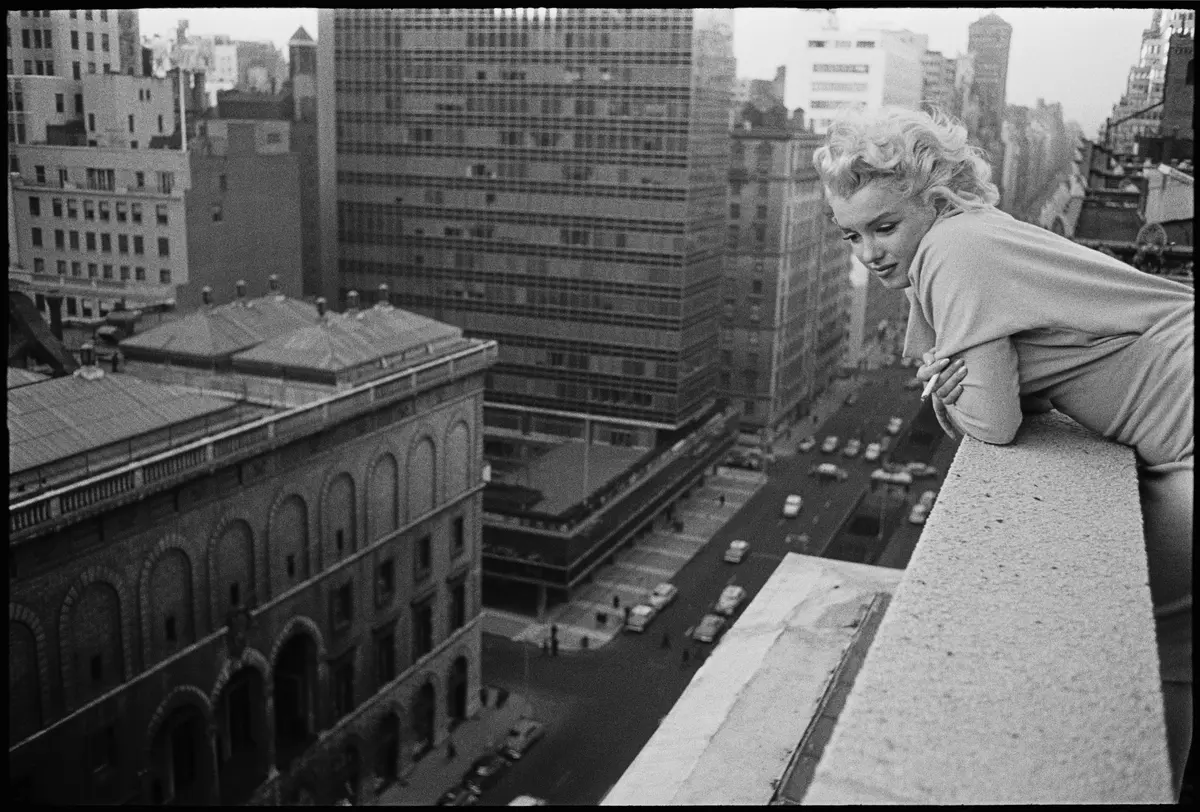
One afternoon in 1955, I was staring into a glass of scotch at the Gladstone Hotel in Manhattan. I had downed several, but they failed to subdue my panic. I was jammed up, and my only hope, sitting across the table and smiling serenely, was my friend Sam Shaw.
As a young editor at Redbook, I had been praised and promoted, which led me to overreach so far that my job was now hanging by the thinnest thread—Sam’s connection to Marilyn Monroe.
After leaving Hollywood to study at the Actors Studio, Marilyn retreated from the spotlight. For the first time in her flashbulb life, she was dodging photographers and reporters.
After two dozen movies, a headline marriage, and a headline divorce, she was in New York to prepare for parts like Grushenka in The Brothers Karamazov. The papers dug out all the clichés about comedians who want to play Hamlet, underlining their ridicule with photos from
My crisis began when I did something way out of character. I saw an ill-lit print of her in an Actors Studio class, covered by a camel’s-hair coat and with no makeup. A line flashed through my head: the Marilyn Monroe you’ve never seen, and, with no hesitation, I persuaded my boss to engrave it on the July cover, which went to press ten days before the rest of the magazine. I was jumping out of a plane without knowing if the parachute would open.
As I took the plunge, I knew who would be with me—my best friend, the photographer Ed Feingersh, who knew all about parachuting. Some of his daring must have rubbed off on me, and we sat in Costello’s saloon planning our assault on Fortress Marilyn.
Three days later, we had nothing. It dawned on me that, while he was a daredevil, Eddie had no gifts as a stalker. The first afternoon, he waited for hours in the lobby of Marilyn’s hotel, took a minute to make a phone call, and returned to find some kids waving the little Kodak Brownies that were the ubiquitous inexpensive camera of the day: “She posed for us!”
With blank pages looming in the July issue, I called Sam, a photographer who wanted to be a movie producer and had worked hard at friendships with Hollywood’s rising generation, among them Elia Kazan, Marlon Brando, and Marilyn. Sam and I had once shared an office, and he agreed to help.
At the Gladstone, Sam had called Marilyn on the house phone. As usual, she was running late. We were nursing our drinks when a tall, tanned man looked into the room and headed for the table.
“Sam, how are you?” said Joe DiMaggio, sitting down. “Marilyn told me you were here.”
A few months earlier, avoiding reporters, as usual, DiMaggio had been seen leaving divorce court in obvious sorrow and anger. Now, here he was, fresh from his former wife’s room, talking, almost babbling about her with a schoolboy smile on his face, telling Sam how happy he was that she was away from “that movie crowd.” Moreover, the notoriously jealous DiMaggio was pressing him to see more of Marilyn. “She wants you to take her antiquing again,” he said, getting up to leave. He gave me a quick nod and smile.
A few minutes later, Sam put me on the house phone, and, in that familiar breathy voice, Marilyn agreed to do the picture story, suggesting we meet for a drink the next afternoon.
“Why,” Marilyn asked soon after we sat down, “do they print things about me that aren’t true?”
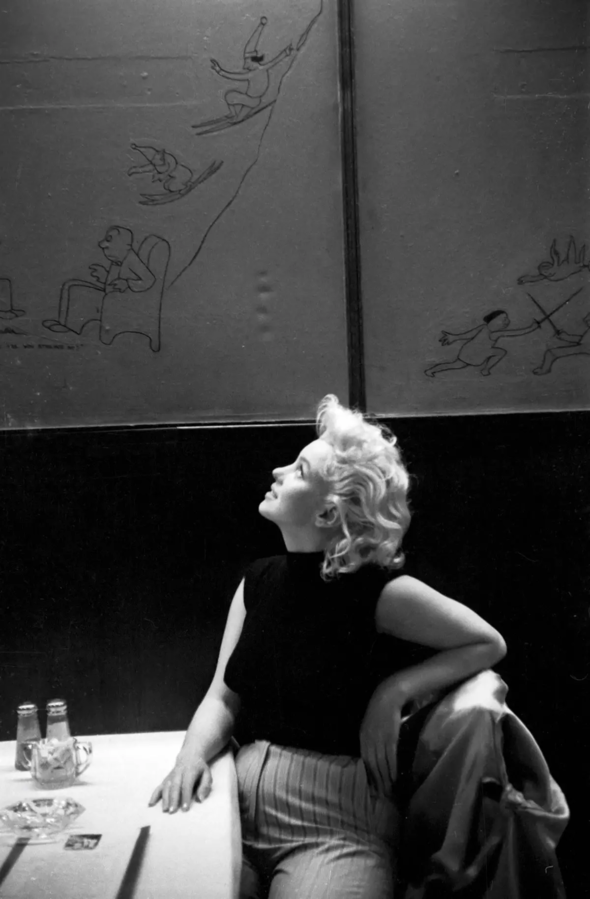
It was not a rhetorical question or a complaint. We were in a cocktail lounge, and she was looking at me over her Scotch Mist with a puzzled expression, waiting for an answer. Up close, her face was pale and fragile, with no Technicolor glow, and her eyes had none of the confidence that radiated from the screen.
Within minutes, it was clear she had no small talk, no social defenses. Sam had told me that, if you ask “How are you?,” she will stop to think, instead of coming back with an automatic “Fine.” And when she asked a question, she waited for an answer.
“Why do they make up stuff?” she persisted.
I took the plunge. “Because pictures of you sell papers and magazines, and when there’s no excuse for running them, they’ll print rumors and gossip, anything they can get.” Something pushed me to go further: “They don’t mean to hurt you, just use you.”
She looked at me with a flinching smile that said she knew all about being used. It set off a flash-back in my mind: Mike Cowles, the publisher of Look, telling of a visit to Twentieth Century–Fox in the late 1940s, when a studio head remarked, “We have a new girl on the lot with something unusual. Instead of sticking straight out, her tits tilt up.” He sent for Marilyn, who came in smiling, and he lifted her sweater to show what he meant. She never stopped smiling.
We talked about Sam for a while, and then, Marilyn said, “There’s another reason I’m doing this: Your magazine never made fun of me.” Her eyes brightened. “Even gave me an award.”
I felt accepted and, at the same time, burdened with her trust. The most famously sexual woman in the world was being childlike and vulnerable, but also using her openness to get what she wanted for a few days: my loyalty. All her life, that mixture of innocence and guile had apparently drawn protectors and betrayers, many of them the same people.
It was not long before one popped up. The next day, I got a call from Milton Greene, a mediocre photographer and world-class hustler who had persuaded her to form a partnership with him called Marilyn Monroe Productions. We can do the story, he said, but only with a photographer on his payroll. I told him to get lost, and when Eddie and I met Marilyn the next day, I related the shakedown attempt. She frowned, and we started on our story. (It took her a while to get the full picture, but, eventually, she fired Greene for mismanagement.)
I told Marilyn we wanted to show her as she really was: no poses, no blowing kisses to the camera, no studio setups, just a straight look at her life.
In the heyday of 35mm cameras and available light, Eddie worshiped Henri Cartier-Bresson, whose pictures were being shown not only in magazines, but in museums. His idol would not allow prints to be cropped, and neither would Eddie. The “decisive moment” was framed in the photographer’s eye, and to change a picture later would be like taking slices off a Renoir or van Gogh. At a time when Italian and French films were showing up Hollywood fluff, Eddie and others were transforming traditional frozen magazine pictures with on-the-fly realism. The world was going grainy.
Alone among them, Eddie wanted to go beyond witnessing an event with the camera, but to enter it and show how it looked from the inside—risking himself for moments nobody had ever seen. He took pictures while crawling with patrols in Korea, lashed to the periscope of a diving submarine, jumping from a plane with paratroops. Back home, on a racetrack with Irish Horan’s Lucky Hell Drivers, he crouched, elbows hugging his body, between boards tented at a 45-degree angle while speeding cars careened by so close that he could see the ply marks on their tires.
Short, thin, and stooped, with a face that was far from handsome, Eddie was magnetic for everyone who knew him. He was as passionate about friendship as work. He was an artist at both.
He lived in the now, letting moments take him wherever they would. Costello’s was more home than hangout. He must have had an apartment or room somewhere, but, in all our years as close friends, I never saw it. He got his mail and phone messages at Costello’s and spent every evening in town at the bar, as people he knew came and went, moving a few feet to a table for food and, later, if the mood was right, slipping coins into the pay phone to ask some young woman to call her friends, while a few of us brought over a bottle to drink and flirt away the night. His energy was unending. He would spend hours talking excitedly, gesturing, scrawling his version of Thurber dogs on napkins, getting up to pace around, crouched like Groucho in a serpentine glide. Life with him was never at a standstill.
Tracking Marilyn, Eddie’s camera was telling more than we knew at the time. The public Marilyn was keeping appointments—fittings for her costume to ride a pink elephant at a charity premiere of the circus, meetings with lawyers and agents (Twentieth Century–Fox had suspended her for decamping), a grand entrance in white furs at the opening night of Tennessee Williams’s new play Cat on a Hot Tin Roof. Before going out, she put on a performance with the stopper from a bottle of Chanel No. 5, stroking her skin in sensuous delight.
But, between moments of being seen, there was another Marilyn, suddenly drained of energy, like the air being let out of a balloon. She sat in a darkening hotel room with drink in hand and went out on the terrace to stare unseeing at the Manhattan skyline. Eddie’s shutter kept clicking, and rolls of 35mm film filled up with images of the Marilyn Monroe you’ve never seen: withdrawn and alone. He never asked her to pose. She hardly knew he was there.
Marilyn had never been in a subway. Wrapped in the camel’s hair coat, her famous hair subdued, she walked to the Grand Central stop of the IRT and down to the platform. Nobody recognized her. Eddie’s camera kept clicking while she stood straphanging on the uptown local. No heads turned.
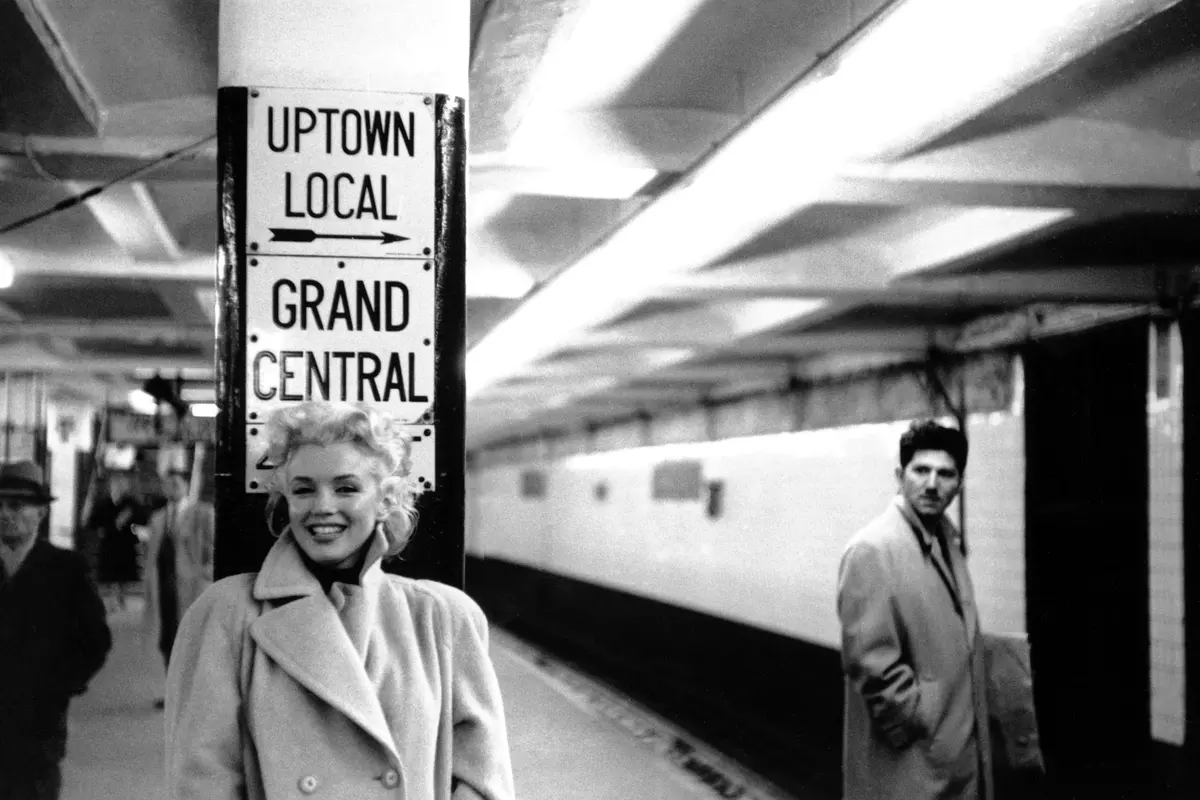
Back up on the street, Marilyn looked around with a teasing smile. “Do you want to see her ?” she asked, then took off the coat, fluffed up her hair, and arched her back in a pose. In an instant, she was engulfed, and it took several shoving, scary minutes to rewrap her and push clear of the growing crowd.
The two Marilyns kept fading in and out. At the costume-fitting, she arrived as the Star, commanding a swarm of tailors, seamstresses, and hangers-on until the Other abruptly emerged and burst into tears of frustration over some detail of the garment. Eddie’s camera got it all, showing her rising tension against a visual jangle of wire hangers in the background. He framed the scene in the fragmented hall-of-mirrors unreality that Orson Welles had created around Rita Hayworth for the finale of
Late one afternoon, Marilyn asked what we did at the end of the day, and we took her to Costello’s. By then, John McNulty had been writing about the place in The New Yorker for years, but the proprietor, Tim Costello, managed to keep it from changing. A stern look over his teacup at the back table was more effective than the rules committee of any private club. Costello’s never went trendy in the way a cabdriver once said of another saloon, “Nobody goes there anymore. It’s too crowded.”
Behind the long bar was a blackthorn walking stick that had been broken over John O’Hara’s head by Ernest Hemingway, no one remembered why. On the facing wall were huge drawings on beaverboard by James Thurber, so valued by Tim that he had had them inked over, varnished, and, when he was forced to move his establishment next door, carefully removed and remounted. The panels were brown with age and tobacco smoke.
Thurber had filled the walls with images of cowardly canines (a dog being chased by rabbits) and little men menaced by huge women (“I’m leaving you, Myra; you might as well get used to the idea,” says one in the clutch of an Amazon several times his size). Such self-mocking masculinity suited the place. Tim did not abide noisy, pugnacious drunks.
Marilyn was wearing a black sleeveless blouse and striped slacks. She sat next to the Thurber drawings at a table across from the bar.
Tim, usually wary of strangers, was clearly intrigued by the blaze of blonde hair at our table and, in a rare gesture, came over to take the orders himself.
“A screwdriver please,” Marilyn said.
Tim was expressionless.
“Vodka and orange juice,” she added.
Tim kept looking at her. “We don’t serve breakfast here,” he said.
“O.K.,” Marilyn said agreeably, “vodka on the rocks.”
Tim gave the order to his brother Joe at the bar and went back to reading his paper. Later, as Eddie was heading to the men’s room, Tim stopped him.
“Who is she?”
Eddie smiled. “Marilyn Monroe.”
Tim’s face darkened. “I ask a civil question and you get smart.”
Eddie smiled again and Tim went back to his paper.
In our hour there, no one else gave Marilyn more than a quick look. As she was leaving, a photographer at the bar tapped Eddie on the arm. “If you come back later,” he stage-whispered, “bring your little friend.”
The pictures in Redbook with my text and captions showed an unfamiliar, vulnerable Marilyn in soft shades of black and gray. The opening spread contrasted her solitary sadness with a long shot of 200 photographers almost trampling the elephant she was riding at the circus.
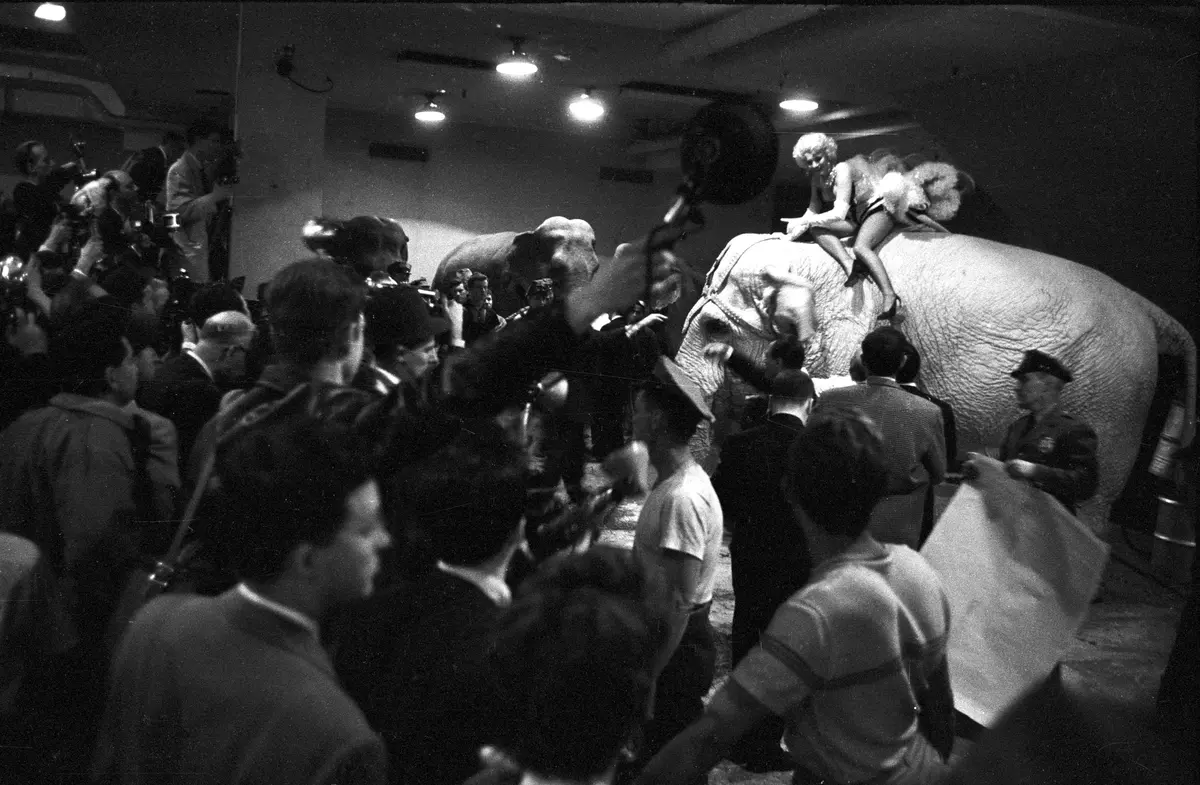
In their days together, despite the disparity in looks, I could see that Eddie and Marilyn were much alike. They both were somehow more directly connected to life than the rest of us, and more vulnerable. Like Marilyn, Eddie was given to self-parody to mask the pain of being defenseless against daily living and, like her, desperate to make full use of the gifts that such an open nature provides.
Just as Marilyn dreaded looking less than perfect in front of the cameras and was always late, so Eddie obsessed over what he did behind the camera, and would let no one else develop or print his pictures.
Each held on to an ideal of Art as if it were life itself, and, as it turned out for both of them, it was. Marilyn’s movies and Eddie’s pictures made those who saw them feel more alive, but, at the same time, fear for their safety, sensing the price that would have to be paid for their luminous openness.
Before the year was out, the Third Avenue El in front of Costello’s was torn down, removing the pillars that Tim’s regulars would use to steady themselves while hailing cabs in the morning hours.
Marilyn’s stay in New York led to her marriage to Arthur Miller and an attempt to become a conventional wife and mother in Connecticut, while making a few movies that showed her acting ability, as well as her amplitude of flesh and spirit.
Eddie got married, too, and then, he was in the crisis of his life.
The Cliff was a bar on Twenty-third Street. Eddie used his last dime for the phone call, and I went down to keep him from going over the edge.
It had started to go bad a couple of years after the Marilyn story. After my wedding, we saw each other less, and so it came as a surprise when he told me he was getting married. She was a blank beauty with high cheekbones and an impervious air who drifted through our times together in a detachment that seemingly spurred Eddie to pour all the energy he used to put into finding the perfect picture into solving her mystery.
At their wedding, I was behind the camera, looking at incongruous images of a picture-book bride in white alongside Eddie’s dark suit and sheepish smile, some part of him seeing it all in helpless bemusement. The marriage lasted a few months, during which he gradually worked less and less, then finally stopped altogether before his bride floated out of his life, leaving behind only her enigmatic stare.
After he called that evening, we sat for hours, trying to figure out what he could do, now that he was too paralyzed to do the one thing in life he was meant to do. Finally, I suggested an answer: “Come work for me. I need a picture editor.”
I was the editor of Redbook by then, and the idea made sense. If Eddie could no longer take pictures, he could imagine them, match photographers to subjects, and help them do good work until he could start doing his own again.
For a few months, it went well. Once in a while, when he was excited about an assignment, I would say, without looking at him, “Of course, you’d be perfect for it,” or, “It’s your kind of story.” Each time, he would freeze for a moment before his eyes went blank and he shook his head.
He cut down on his drinking, but the depression got worse. Gradually, he came into the office less and less, and finally, not at all. Then came a phone call from a woman who had been in love with him for years. He had arrived at her door the evening before and died in his sleep during the night.
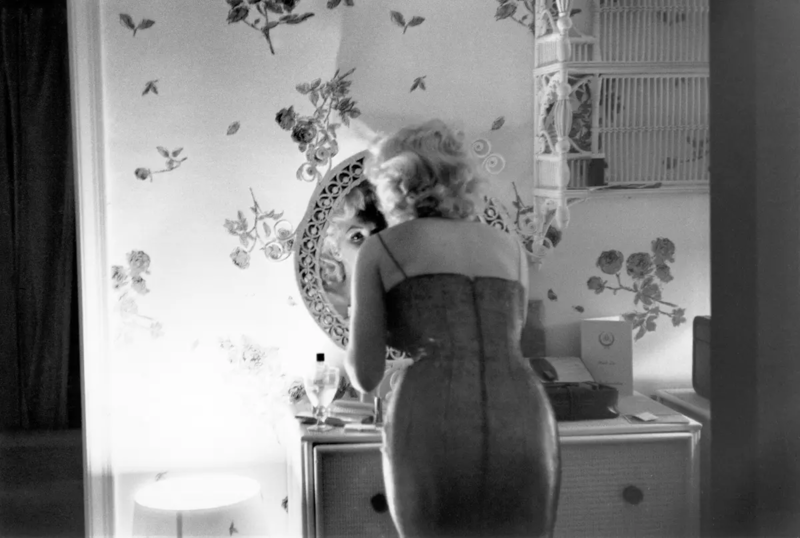
Over the years, I had urged Eddie to try a psychiatrist, but my pleading could not break through his certainty that suffering was inseparable from his gift, that he could not escape one without losing the other. In today’s world he—and Marilyn, for that matter —might have been kept going by medication, but back then, there was no such lifeline.
Ever since, those who loved Eddie’s work have tried to get museums to give him the recognition he deserves. But it has been no easier to help him in death than it was during his life. Almost all his prints and negatives, so closely held, scattered and disappeared, magnificent pictures lost forever.
Yet something of him remains alive, linked forever with that other lost soul. On websites in many languages, people are selling prints of a few of those pictures that Eddie took of Marilyn that week in 1955. The negatives were found in a warehouse three decades after his death.
Marilyn has inspired rescue fantasies in legions of writers, among them Norman Mailer and Gloria Steinem. Toward the end of his life, Arthur Miller looked back and saw himself that way. “I spent five years trying to keep her from falling off the cliff,” he told an interviewer in 2004 while justifying
As Eddie’s would-be savior, I am left with no such soothing consolation, only an abiding sense of loss.

